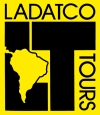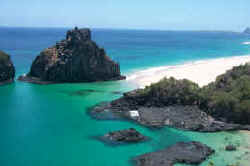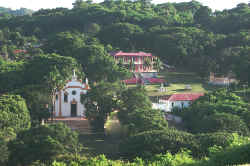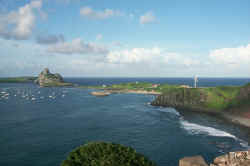
Custom Designing Pampered Adventure since 1966

Destinations
Experiences
 |
L A D A T C
O T O U R S Custom Designing Pampered Adventure since 1966 |
 |
||||||||
| HOME | South America | Falkland Islands | Antarctica | Unique Destinations |
Unique Experiences |
Newsstand | ||||
|
Fernando de
Noronha, About
Fernando de Noronha |
|
 |
 |
 |
 |
ABOUT FERNANDO DE NORONHA:
LOCATION: Located 332 miles off the Brasilian coastal city of Recife, Fernando de Noronha is the largest and only inhabited island in an archipelago of 21 islands and islets. The entire archipelago was declared a Marine National Park in 1988 and today is administered by the Brasilian state of Pernambuco. All together 70% of the archipelago is considered National Park.
HISTORY: Fernando has a colorful history. Discovered in 1503 by Amerigo Cespucci, they were for a time a popular pirate's lair. It was invaded many times, passing through Dutch, English and French hands until in 1737 the French were driven out by the Pernambuco captaincy. Ten forts were built around the island to protect Pernambuco's ownership. The main fort, Forte dos Remedios, was completed in 1738 and sits atop a hill overlooking the traditional town center. Through the years the fort has been used as a penitentiary for common and political prisioners.
The island, besides serving as a political and common criminal prison, has also been home to military installations, including an American base during World War II.
TODAY: Today the island population is around 3000 inhabitants, dedicated to civil service, fishing, agriculture and the growing tourism and hospitality sector. Vila dos Remedios is where most people live and socialize. Here you will find a cluster of homes and "pousadas", a few stores, the post office, administration center, church and museum. The island has over 100 small "pousadas" spread out over the island, and none located directly on the beach.
There is one main two lane paved highway, BR 363, the shortest national highway in Brasil! Numerous "tracks", some maintained with most rutted and bumpy, criss-cross the island, linking the main road and the main sites.
There are areas of the island that are under "environmental" protection that are not part of the park. These areas include the airport, the Vila dos Remedios, the harbor, park headquarters, school and hospital. The rest belongs to the park, administered by IBAMA. Certain aires are open to the public, other areas are strictly closed.
The state government controls the entrance and departure of tourists, whose numbers can not exceed 500 visitors simultaneously.
BEACHES: Fernando has 16 beaches, all of them beautiful. Some are accessible and some are off-limits. Cachorro Beach is right at the village, below the fort; Sancho Bay is visited on the motorlaunch trips and can also be accessed via an old metal ladder in a narrow crack in a rock which links the beach and the top; Porcos Bay has natural rock-formed aquariums complete with fish.
In September the side of the island facing Brasil is extremely calm, with intense sunshine and crystal clear waters. In August there is the Ocean Fishing Championship and in September the Ocean Regatta from Recife to Fernando de Noronha, a maritime advisenture of 300 miles attracting around 40 sailors.
From December to March the wind and currents transfer for the same beaches into perfect surfing beaches, with waves of up to 12 feet.
WILDLIFE: The island has never been inhabited by large mammals, except those brought by man. There are several species unique to the islands, including a two-headed snake, which is not a snake but a worm and doesn't even have two heads. There are various breeding colonies of local seabirds as well as migratory birds.
In the Baia dos Golfinhos, the whole area is reserved for the charming spinning dolphins (Stenella Longirotis) to rest and mate. They delight visitors of all ages with their magnificent leaps and aerial arcobatics. Every day, at dawn, the dolphins come into the bay and in the afternoon they go out to sea in search of food. Fernando de Noronha is one of the few places in the world where there are breeding colonies of spinning dolphins.
On the beaches of Leoa and Sancho there are to be found hatcheries of the "aruana" sea turltes (Chelonia Mudas), also known as green turtles. They are protected by IBAMA through the TAMNAR project and can be seen from November, in groups on the sea surface. This is when breeding season begins. From December to May the females climb the beaches to lay their eggs and after 50 days baby turtles make their eway to the sea.
There are a series of 8 trails along old stone convict built paths or along the beaches edge. Three of the trails are outside the Marine National Park and five within the park, all giving an excellent chance to view the diversity of the landscape and environment.
SNORKELING & DIVING: The marine life offers superbe snorkeling and scuba diving. The region is bathed by the northern stream of the southern equatorial current, which brings clear, warm water with an average temperature of 26C and visibility up to 50m (150 feet). The marine fauna with its great variety of fish and colorful corals surprises even most experienced divers. Two species of sea turtles, spinner dolphins and the occasional shark are usually seen. There is a shipwreck at Santo Antonio; Sueste Bay has a sea bed of corals.
Fernando is also considered one of the prime diving spots on earth. Locals say there has never been a shark attack in the last 500 years because the ecology is perfectly balanced and the sharks have plenty to eat. Three excellent dive companies provide complete outfitting. All dives are accompanied by local dive masters. Diving ranges from tranquil of Ressureta Bay between 18 and 36 feet deep to the adrenalin rush of 165 feet dive to a shipwreck.
SEASONS: The rainy season is April to July, and the vegetation is lush and green. The dry season is August to April, and the vegetation loses its color and looks more like scrubland. The best surfing is December to March, the best diving July through October.